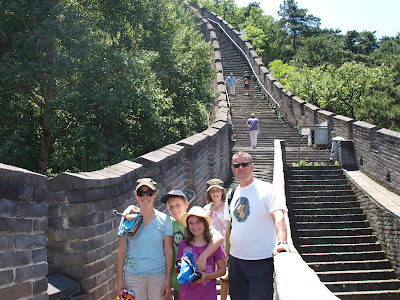Along the road, vendors sit at the stalls selling all the local fruit that’s in season — peaches, cherries, apples, pears and watermelons.
Once we shoehorned our bus into the crowd, we walked up, past a long line of vendors, all selling identical kit. Cries of “Hey Rady! Wat a hat rady?” followed us up the hill. Mao t-shirts, ugly sunhats and golden waving cats all the way up to the chairlift. A long hike with four-year-old in tow was out of the question and in this heat it was a blessed relief to not have planned anything more strenous. Although getting off the chairlift without skis was an interesting experience.
The setting was mindboggling. Rough mountains of green with pale peach rock jutting out along the crests. The chain stretched off forever and it seemed atop every peak in sight was a pale string peppered with the occasional tower. As the string got closer, the wall came into focus. Originally constructed 2200 years ago, the wall was rebuilt and lengthened a further 2000 kilometres in 1404 — all to keep out those crazy Mongolians. Hard to imagine anyone getting over the structure but apparently the Mongolians managed in the 13th century, in the first war where firearms played a role. The distant past somehow feels very present in this country.
I still can’t quite believe we are here. The steps are uneven, sometimes four inches high, sometimes over a foot. We huffed and we sweated and were awestruck by this infinitesimally small part of the whole 6000 kilometres of wall that is restored and open to the public. The Mutianyu section we were on was short but spectacular. Crazy to think that beyond the section that was open to the public lie thousands of kilometres of overgrown wall.
The way down was a total hoot. On a toboggan. We all piled up on top of one another, going far slower than most of us would’ve liked but it was a blast all the same. We stopped in at a little country restaurant. The waitresses were gorgeous — teeny-tiny, wide-open wide Mongolian faces, meek and super smiley. Abby took on the menu and we feasted again. Way too much food. I thought that I would tire of eating Chinese but the variety and depth of flavours available could keep me going a long time yet. Roasted rainbow trout, dry-rubbed lamb with onions and cumin, chicken and chestnuts, taro-filled spring rolls dipped in sesame seeds, a crazy dish of sweet corn with deep-fried batter and sugar sprinkled on top. Delish.
We rolled on, stopping in at 798 art district, a former factory emptied in the government’s efforts to clean up the city by moving industry out of the centre. The unpolished, raw feel of the factory an amazing backdrop for contemporary art. It was a lot of fun to poke around and see what artists are doing in Beijing, not to mention check out all the best haircuts in town.
The drive was a welcome opportunity to pepper Eric with questions about life in China. He told us about the one-child policy, explaining that most people felt it a good idea to control the population — competition for jobs & housing being cutthroat as it is. The thinking is long-term and I can’t help but admire his ability to see the merits of a policy that will only benefit the generations to come. He did say that people ten years his junior had a lot of difficulty finding life partners, that only the richest, best-looking men get married. As a Manchurian, one of over fifty minorities that make up less than eight percent of the population of China, he’d be allowed two children.
He “celebrated” his 40th birthday just a few days ago. Manchurian tradition dictates that one doesn’t mark one’s birthday in any way if one’s parents are still alive. He told us that his birthday treat was the extra long noodles his mother would make him to signify longevity. He also told us that he was related to the Imperial family and would be a prince had history taken another turn. He is a lovely, funny guy. If any of you are planning a trip to Beijing I will happily hook you up with the best guide in town.
We dined at Dadong, the smallest in a chain of three restaurants in Beijing specializing in Peking Duck. To put it in perspective the largest of the three seats three thousand. In the centre of the restaurant stand four tall wood ovens manned by an army of chefs wielding big hooks they use to poke into the ovens. Between the ovens sits a wrought-iron frame where the cooked ducks are hung to drain before being transferred to waiting platters. Again we feasted, managing to fill the lazy susan that was five feet across with savoury dishes. If this is communism, it bears absolutely no resemblance to the ideology I learned about it in school. Bugati, Gucci, Chanel shops line the boulevards. The plentiful malls are filled with well-dressed people shopping for all the latest name brands. I’ve no doubt that much of what we've experienced is totally inaccessible to the vast majority of Chinese but there are people getting ahead here. Our visit has totally muddled all my thoughts about China. I can’t wait to see more. We’re off to Chengde tomorrow which, by happy coincidence, is Eric’s hometown so he’s coming along. In a country with dozens of cities of over two million people, Chengde’s population of half a million makes it a village by Chinese standards. There is a good chance that facebook and blogspot are blocked as they are everywhere but in this hotel. In the meantime I’ll keep typing and see when I next get online.







No comments:
Post a Comment